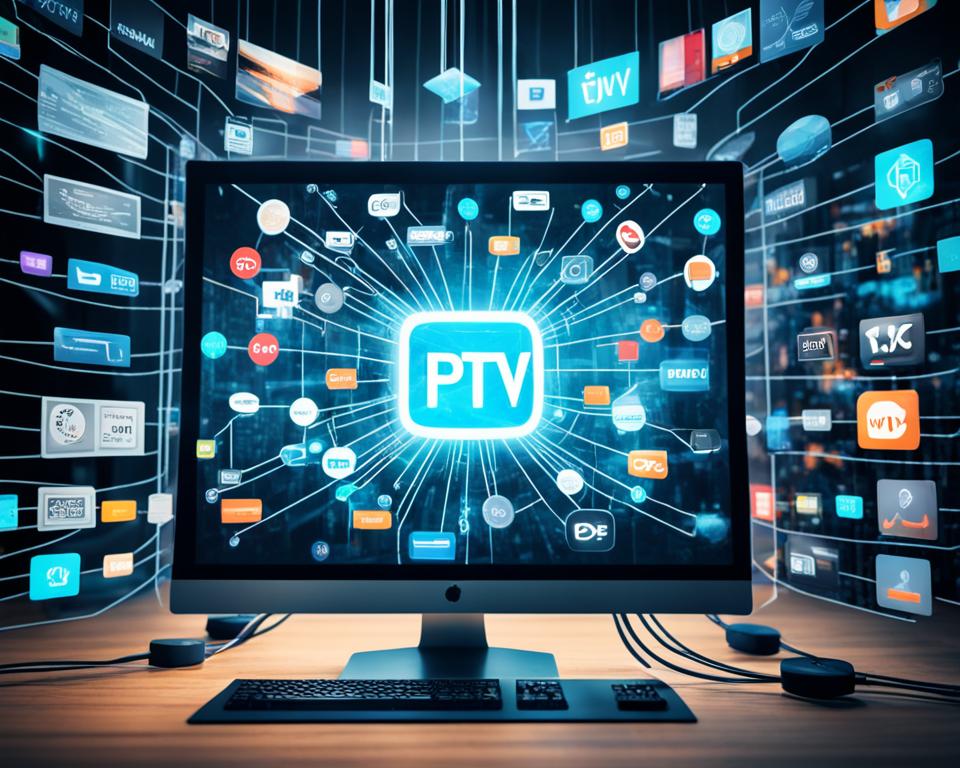Did you know that video content is projected to account for 82% of all internet traffic by 2022? With the rise of Internet Protocol Television (IPTV), professionals now have a powerful tool at their disposal to enhance their online presence, build their brand identity, and connect with a wider audience. In this article, we’ll explore how IPTV can transform the way professionals approach digital marketing, content creation, and brand building.
- Video content is projected to account for 82% of all internet traffic by 2022.
- IPTV offers professionals the opportunity to enhance their online presence and brand identity.
- By leveraging IPTV, professionals can reach a larger audience and connect with them through impactful video content.
- IPTV provides personalized and interactive marketing opportunities, creating a more engaging user experience.
- IPTV can be integrated with social media and user-generated content to increase brand awareness and loyalty.
What is IPTV Content Delivery and Distribution?
IPTV content delivery and distribution are integral processes for transmitting and storing IPTV content from the source to end users. This involves a network of components working together to ensure seamless delivery and accessibility of content.
Content servers are responsible for creating and encoding the IPTV content. They play a vital role in managing the content and making it available for distribution.
Content delivery networks (CDNs) act as the distribution backbone, ensuring efficient delivery of IPTV content to different locations. CDNs optimize the delivery process by caching content in servers located strategically across various geographical regions.
IPTV middleware facilitates communication between the content servers, CDNs, and user devices. It enables seamless interaction and ensures smooth transmission of content.
Set-top boxes play a crucial role in receiving the content and decoding it for playback on television screens. These devices enable users to access IPTV services and interact with the content.
User devices, such as smartphones, tablets, and computers, are used to access IPTV content through dedicated applications or web interfaces. These devices provide flexibility and convenience for users to consume IPTV content wherever they are.
Components of IPTV Content Delivery and Distribution
| Component | Description |
|---|---|
| Content Servers | Create and encode IPTV content |
| Content Delivery Networks (CDNs) | Distribute IPTV content to different locations |
| IPTV Middleware | Manage communication between servers, CDNs, and user devices |
| Set-Top Boxes | Receive and decode IPTV content for playback on television screens |
| User Devices | Access IPTV content through applications on smartphones, tablets, and computers |

How Can IPTV Content Delivery and Distribution Benefit Marketing?
IPTV content delivery and distribution offers valuable opportunities for marketing professionals to enhance their strategies and reach a target audience effectively. Let’s explore how IPTV can benefit marketing efforts:
1. Targeted and Personalized Ads
IPTV enables the creation and delivery of targeted ads, ensuring that the right message reaches the right audience. By analyzing user preferences and behavior, marketers can tailor ads to individuals or specific groups, increasing engagement and conversion rates.
2. Interactive Ads for Enhanced Engagement
IPTV provides interactive ad formats that encourage user participation and engagement. With features like clickable links, surveys, and quizzes, viewers can actively interact with brands, making the ad experience more engaging and memorable.
3. Showcasing Branded and Sponsored Content
IPTV allows marketers to showcase branded and sponsored content, providing an opportunity to highlight a brand’s value proposition and build brand recognition. By integrating branded content seamlessly into IPTV channels, businesses can effectively reach their target audience and increase brand awareness.
4. Integration with Social Media
Combining IPTV with social media platforms creates a powerful marketing strategy. Marketers can leverage user-generated content and promote it through IPTV channels, encouraging audience participation and driving social media engagement. This integration helps increase brand visibility and loyalty.
5. Amplifying User-Generated Content
User-generated content (UGC) is a valuable asset for marketing campaigns. With IPTV, businesses can curate and feature UGC on their channels, showcasing real experiences and testimonials from satisfied customers. This approach helps build trust, authenticity, and social proof for the brand.
6. Table: Comparison of IPTV Content Delivery and Traditional TV Advertising
| IPTV Content Delivery | Traditional TV Advertising |
|---|---|
| Targeted and personalized ads | Limited targeting capabilities |
| Interactive ad formats | Passive viewing experience |
| Seamless integration with social media | Limited social media integration |
| Amplification of user-generated content | Less emphasis on user-generated content |
The Benefits of IPTV Content Delivery and Distribution for Marketing
Utilizing IPTV content delivery and distribution for marketing offers several advantages. Let’s explore how IPTV can benefit marketing efforts:
1. Reach a Large and Diverse Audience
IPTV allows content providers and marketers to reach a vast and diverse audience. With its wide availability and accessibility, IPTV enables marketers to target specific demographic segments, ensuring that their message reaches the right people at the right time.
2. Enhanced User Experience
IPTV offers an immersive and interactive user experience. By delivering personalized and relevant content, IPTV enhances user engagement, satisfaction, and loyalty. The ability to tailor content and ads based on user preferences creates a more satisfying viewing experience for the audience.
3. Improved Marketing Performance
IPTV provides valuable insights through data analytics, enabling marketers to optimize their marketing campaigns and achieve better performance. By analyzing viewer behavior, preferences, and engagement metrics, marketers can make data-driven decisions to refine their strategies, resulting in improved marketing performance and ROI.
4. Strong User Relationship
IPTV allows marketers to build a strong and lasting relationship with their audience. By delivering valuable and customized content and ads, marketers can establish trust and credibility, fostering a loyal and engaged user base. This strong user relationship leads to higher brand affinity and advocacy.
By leveraging IPTV content delivery and distribution, marketers can tap into a large and diverse audience, enhance user experience, improve marketing performance, and build strong relationships with their users. These benefits make IPTV a highly effective tool for driving successful marketing campaigns.

The Challenges of IPTV Content Delivery and Distribution for Marketing
Using IPTV content delivery and distribution for marketing presents certain challenges. The IPTV market is fragmented, making it difficult to cater to diverse user preferences. Security and privacy of content and data are concerns that need to be addressed. Managing the complexity and cost of the content delivery system requires technical expertise and resources. Balancing the quantity and quality of content and ads can be challenging to maintain relevance and avoid being perceived as intrusive.
Fragmented Market
The IPTV market is diverse and constantly evolving, with multiple platforms and providers offering a wide range of content options. This fragmentation makes it challenging for marketers to identify the most effective channels and reach their target audience effectively. Understanding the preferences and habits of users across different platforms and devices requires market research and ongoing analysis.
Security and Privacy Concerns
With the increasing amount of digital content and data being transmitted through IPTV, ensuring security and privacy has become a significant concern. Content providers and marketers need to implement robust encryption and authentication measures to safeguard sensitive information. Additionally, complying with privacy regulations and obtaining user consent for data collection are essential steps to maintain trust and protect user privacy.
Technical Expertise and Resources
Operating an IPTV content delivery system requires specialized technical knowledge and resources. Managing the infrastructure, including content servers, CDNs, and streaming protocols, demands expertise in networking, encoding, and system administration. Organizations must invest in technical talent and infrastructure to ensure a seamless and reliable content delivery experience.
Balancing Quantity and Quality
In an effort to provide a diverse range of content and maximize revenue opportunities, there is a risk of compromising the quality and relevance of the content and ads. Marketers must find a delicate balance between offering a sufficient quantity of content and maintaining high standards of quality. The content should engage and resonate with the target audience while avoiding overwhelming users with excessive or irrelevant ads.

| Challenges | Solutions |
|---|---|
| Fragmented market | Conduct market research to identify target audience and platforms. Develop a multi-channel strategy to reach diverse users effectively. |
| Security and privacy concerns | Implement strong encryption and authentication measures. Comply with privacy regulations and obtain user consent for data collection. |
| Technical expertise and resources | Invest in technical talent and infrastructure. Leverage managed service providers for efficient content delivery system management. |
| Balancing quantity and quality | Focus on creating high-quality, relevant content. Use data analytics to understand user preferences and deliver personalized experiences. |
Video, Petabyte-Scale Data Storage, and Temporal Analytics in IPTV
IPTV involves the management of video content, petabyte-scale data storage, and temporal analytics. Video understanding is crucial for the development of AI applications, especially those that rely on video-based technologies like object recognition and facial recognition. To handle the vast amount of content in IPTV, a robust and scalable data storage infrastructure is required, capable of managing petabyte-scale data storage. Temporal analytics involves analyzing behavioral and network data, which are stored with timestamps to identify patterns and trends over time.
Proper data normalization and optimization play a vital role in achieving efficient and parallelized processing of data in IPTV systems. Normalization ensures that data is organized and structured in a consistent manner, enabling accurate analysis and decision-making. Parallelized processing, on the other hand, allows for the concurrent execution of multiple tasks, significantly improving processing speed and performance.
Comparison of Video Understanding Technologies
| Technology | Advantages | Limitations |
|---|---|---|
| Object Recognition |
|
|
| Facial Recognition |
|
|
| Video Content Analysis |
|
|
By utilizing video understanding, petabyte-scale data storage, and temporal analytics, IPTV providers can enhance content recommendations, improve user engagement, and optimize their service offerings. The integration of these technologies empowers IPTV platforms to deliver personalized and engaging video experiences to their viewers.
Leveraging IPTV Knowledge for AI Applications
The knowledge and expertise gained from working in IPTV can be valuable for AI applications. Understanding video and its nuances helps in developing AI models for video-based tasks. Dealing with massive-scale data in IPTV can provide insights into managing and optimizing infrastructure for AI projects. Temporal analytics skills are transferable to AI, as both involve analyzing behavioral and temporal data.
AI applications rely on robust and accurate models to process and understand video content. By leveraging their IPTV knowledge, professionals can contribute to the development of AI models that excel at video-based tasks. With a deep understanding of video characteristics, such as motion, objects, and scenes, IPTV experts can provide valuable insights for training AI algorithms. This expertise can significantly enhance the performance and accuracy of video understanding models used in various AI applications.
Furthermore, IPTV involves handling massive-scale data, including video content and user interactions. This experience can be invaluable when it comes to managing and optimizing infrastructure for AI projects. Developing effective strategies for data storage, retrieval, and processing is crucial to ensure seamless and efficient AI operations. IPTV professionals with expertise in infrastructure management can offer valuable insights for designing and implementing robust data pipelines that handle the massive-scale data requirements of AI applications.
Temporal analytics, a key component of IPTV, involves analyzing behavioral and temporal data, often stored with timestamps. This skill set is directly relevant to AI applications that deal with time-series data, such as analyzing user behavior patterns or predicting future events. IPTV professionals well-versed in temporal analytics can contribute their expertise to the development of AI models that leverage temporal data for improved predictions and insights.
By leveraging their IPTV knowledge for AI applications, professionals can bridge the gap between these two domains and contribute to the advancement of both industries. The combination of video understanding, massive-scale data management, and temporal analytics skills positions IPTV experts as valuable assets in the AI landscape.
The Future of IPTV Service
The future of IPTV service is poised to revolutionize the way we consume and interact with digital content. With advancements in technology and changing consumer preferences, IPTV is set to offer a personalized and immersive viewing experience like never before.
Personalization for Tailored Content Recommendations
One of the key developments in the future of IPTV service is the integration of advanced algorithms that enable personalized content recommendations. With deep insights into user preferences and behavior, IPTV platforms will curate content that aligns with individual tastes and interests. This targeted approach will enhance user satisfaction and ensure a customized viewing experience.
Integration with IoT for Seamless Control
The integration of IPTV with the Internet of Things (IoT) will enable users to have seamless control over their IPTV services through connected devices. Imagine being able to start watching a movie on your smart TV and seamlessly continue where you left off on your smartphone or tablet. IoT integration will also allow for voice commands and smart home integration, providing a truly connected and convenient entertainment experience.
Enhanced Interactivity for Active Content Consumption
The future of IPTV service will bring enhanced interactivity, allowing viewers to actively participate in content consumption. This can include interactive quizzes, polls, and real-time feedback during live events. Viewers will have the ability to engage directly with content creators and fellow viewers, fostering a sense of community and engagement.
AR and VR Integration for Immersive Viewing Experiences
Augmented Reality (AR) and Virtual Reality (VR) technologies will be seamlessly integrated into IPTV services, providing viewers with immersive and engaging viewing experiences. Imagine watching a sports event in VR, feeling like you’re right in the middle of the action, or exploring a virtual environment in an interactive documentary. AR and VR integration will unlock new dimensions of storytelling and entertainment.
| Benefits | Features |
|---|---|
| Personalized content recommendations | Advanced algorithms tailored to individual preferences |
| Seamless control through connected devices | Integration with IoT for convenient access and management |
| Active content consumption | Enhanced interactivity through quizzes, polls, and real-time feedback |
| Immersive viewing experiences | Integration of AR and VR technologies |
How to Launch an IPTV Business
Launching an IPTV business involves several essential steps that can set you up for success. From conducting thorough market research to designing a seamless user experience, each aspect plays a crucial role in building a thriving IPTV service. Here are the key elements to consider:
1. Market Research
Before embarking on launching your IPTV business, it’s vital to conduct comprehensive market research. Understand your target audience and their preferences, study competitors and their offerings, and identify gaps or opportunities in the market. This research will help you tailor your content strategy and positioning to meet the needs of your intended viewers.
2. Content Acquisition
The success of an IPTV service relies heavily on the availability of diverse and appealing content. To attract and retain subscribers, you’ll need to acquire licenses and partnerships for a wide range of TV shows, movies, documentaries, and live events. This content acquisition process ensures that your IPTV business offers an extensive library of captivating entertainment options.
3. Infrastructure Setup
Creating a robust and reliable infrastructure is essential for delivering high-quality IPTV content to your viewers. Set up content servers, implement content delivery networks (CDNs) to distribute content efficiently, and configure streaming protocols to ensure optimal streaming performance. A well-structured infrastructure is the backbone of your IPTV business.
4. User Experience Design
A seamless and engaging user experience is critical for attracting and retaining customers. Invest in user experience design and interface development to create an intuitive and user-friendly IPTV platform. Prioritize features such as easy navigation, personalized recommendations, and interactive interfaces to enhance viewers’ satisfaction and encourage longer viewing sessions.
5. Marketing and Promotion
Once your IPTV business is set up, it’s important to develop a robust marketing and promotion strategy. Utilize digital marketing channels, social media platforms, and targeted advertising campaigns to reach your target audience. Highlight your unique selling points, such as exclusive content or superior user experience, to differentiate your IPTV service from competitors.
6. Ongoing Optimization
Launching an IPTV business is just the beginning. Continuously monitor and analyze user behavior, content performance, and market trends to make data-driven decisions. Actively seek user feedback to refine your offerings and improve the viewer experience. Regularly update your content library, add new features, and optimize your infrastructure to stay ahead in the competitive IPTV industry.
By following these steps and leveraging market research, content acquisition, infrastructure setup, and user experience design, you can successfully launch and grow an IPTV business that captivates audiences and stands out in the market.
Conclusion
Leveraging the power of IPTV for personal branding and professional growth can greatly benefit professionals in today’s digital age. By harnessing the capabilities of IPTV, professionals have the opportunity to create impactful video content that not only enhances their online presence but also builds a strong brand identity.
Through IPTV’s content creation and distribution abilities, professionals can position themselves as experts in their respective fields and attract a larger audience. By consistently delivering engaging and valuable video content, professionals can establish credibility, gain trust, and cultivate a loyal following. IPTV provides the platform for professionals to showcase their skills, expertise, and unique perspectives, thereby enabling personal branding on an unprecedented scale.
Branding strategies play a fundamental role in the success of professionals. IPTV offers a dynamic avenue for professionals to execute their branding strategies effectively. By leveraging the interactive and personalized features of IPTV, professionals can deliver targeted and engaging content to their audience, thereby forging a stronger connection and fostering brand loyalty.
In conclusion, incorporating IPTV into personal branding strategies empowers professionals to leverage their expertise, showcase their unique value, and connect with a broader audience. By harnessing the potential of video content creation and distribution, professionals can establish themselves as industry leaders, expand their professional networks, and elevate their careers to new heights.
FAQ
What is IPTV content delivery and distribution?
How can IPTV content delivery and distribution benefit marketing?
What are the benefits of IPTV content delivery and distribution for marketing?
What are the challenges of IPTV content delivery and distribution for marketing?
What role does video play in IPTV?
How can IPTV knowledge be leveraged for AI applications?
What is the future of IPTV service?
How can I launch an IPTV business?






